 W
WA front panel was used on early electronic computers to display and allow the alteration of the state of the machine's internal registers and memory. The front panel usually consisted of arrays of indicator lamps, digit and symbol displays, toggle switches, dials, and push buttons mounted on a sheet metal face plate. In early machines, CRTs might also be present. Prior to the development of CRT system consoles, many computers such as the IBM 1620 had console typewriters.
 W
WThe S-100 bus or Altair bus, IEEE696-1983 (withdrawn), is an early computer bus designed in 1974 as a part of the Altair 8800. The S-100 bus was the first industry standard expansion bus for the microcomputer industry. S-100 computers, consisting of processor and peripheral cards, were produced by a number of manufacturers. The S-100 bus formed the basis for homebrew computers whose builders implemented drivers for CP/M and MP/M. These S-100 microcomputers ran the gamut from hobbyist toy to small business workstation and were common in early home computers until the advent of the IBM PC.
 W
WThe SS-50 bus was an early computer bus designed as a part of the SWTPC 6800 Computer System that used the Motorola 6800 CPU. The SS-50 motherboard would have around seven 50-pin connectors for CPU and memory boards plus eight 30-pin connectors for I/O boards. The I/O section was sometimes called the SS-30 bus.
 W
WThe Acorn System 1, initially called the Acorn Microcomputer (Micro-Computer), was an early 8-bit microcomputer for hobbyists, based on the MOS 6502 CPU, and produced by British company Acorn Computers from 1979.
 W
WThe Rockwell AIM-65 computer was a development computer introduced in 1978 based on the MOS Technology 6502 microprocessor. The AIM-65 was essentially an expanded KIM-1 computer. Available software included a line-oriented machine code monitor, BASIC interpreter, assembler, Pascal, PL/65, and FORTH development system. Available hardware included a floppy disk controller and a backplane for expansion.
 W
WThe Altair 8800 is a microcomputer designed in 1974 by MITS and based on the Intel 8080 CPU. Interest grew quickly after it was featured on the cover of the January 1975 issue of Popular Electronics and was sold by mail order through advertisements there, in Radio-Electronics, and in other hobbyist magazines. The Altair is widely recognized as the spark that ignited the microcomputer revolution as the first commercially successful personal computer. The computer bus designed for the Altair was to become a de facto standard in the form of the S-100 bus, and the first programming language for the machine was Microsoft's founding product, Altair BASIC.
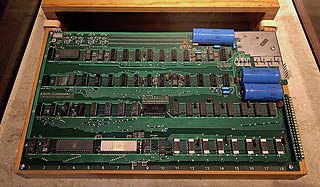 W
WThe Apple Computer 1, originally released as the Apple Computer and known later as the Apple I, or Apple-1, is a desktop computer released by the Apple Computer Company in 1976. It was designed and hand-built by Steve Wozniak. The idea of selling the computer came from Wozniak's friend Steve Jobs. The Apple I was Apple's first product, and to finance its creation, Jobs sold his only motorized means of transportation, a VW Microbus, for a few hundred dollars, and Wozniak sold his HP-65 calculator for $500. Wozniak demonstrated the first prototype in July 1976 at the Homebrew Computer Club in Palo Alto, California.
 W
WThe ITT 2020 was an Apple II computer clone manufactured by ITT under license from Apple Computer, specifically for the European market. In the Benelux, it was distributed by Bell Telephone mfg. company. It was distributed in the United Kingdom by Microsense Computer Limited.
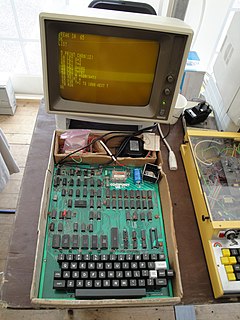 W
WThe Compukit UK101 microcomputer (1979) is a kit clone of the Ohio Scientific Superboard II single-board computer, with a few enhancements for the UK market - notably replacing the 24×24 screen display with a more useful 48×16 layout working at UK video frequencies. The video output is black and white with 256 characters generated by a two kilobyte ROM. It has no bit-mapped graphics capability. The video is output through a UHF modulator, designed to connect to a TV set.
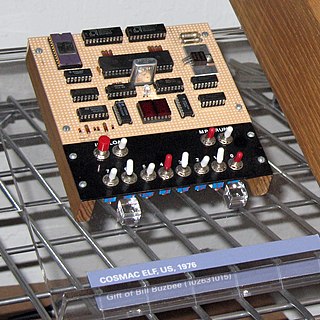 W
WThe COSMAC Elf was an RCA 1802 microprocessor-based computer described in a series of construction articles in Popular Electronics magazine in 1976 and 1977. Through the back pages of electronics magazines, both Netronics and Quest Electronics offered low-priced, enhanced kits that were based on this design. The system was a very early single-board personal computer. It was operated without built-in ROMs and programs were entered directly with help of the CPU integrated DMA using 8 toggle switches and an Input push button.
 W
WThe COSMAC VIP (1977) was an early microcomputer that was aimed at video games. Essentially, it was a COSMAC ELF with a supplementary CDP1861/CDP1864 video display chip. For a price of US$275, it could be purchased from RCA by mail order. It came in kit form, and had to be assembled. Its dimensions were 22 x 28 cm, and it had a RCA 1802 processor; along with a crystal clock operating at 1.76 MHz. It had 2 KB of RAM, which could be expanded to 4 KB on board, and 32 KB via an expansion slot. Its 5V DC CDP18S023 power supply had an output of 600 mA. I/O ports could be added to connect to sensors, interface relays, an ASCII keyboard, or a printer.
 W
WZ-2 is a series of microcomputers made by Cromemco, Inc. which were introduced to the market in the middle to late 1970s. They were S-100 bus machines powered by the Zilog Z80 processor and typically ran on the CP/M operating system.
 W
WThe Datapoint 2200 was a mass-produced desktop personal computer, designed by Computer Terminal Corporation (CTC) founders Phil Ray and Gus Roche and announced by CTC in June 1970. It was initially presented by CTC simply as a versatile and cost-efficient terminal for connecting to a wide variety of mainframes by loading various terminal emulations from tape rather than being hardwired as most contemporary terminals, including their earlier Datapoint 3300. However, Dave Gust, a CTC salesman, realized that the 2200 could meet Pillsbury Foods's need for a small computer in the field, after which the 2200 was marketed as a stand-alone computer. Its industrial designer John "Jack" Frassanito has later claimed that Ray and Roche always intended the Datapoint 2200 to be a full-blown personal computer, but that they chose to keep quiet about this so as not to concern investors and others. Also significant is the fact that the terminal's multi-chip CPU (processor)'s instruction set became the basis of the Intel 8008 instruction set, which inspired the Intel 8080 instruction set and the x86 instruction set used in the processors for the original IBM PC and its descendants.
 W
WThe EDUC-8, pronounced "educate", was an early microcomputer kit published by Electronics Australia in a series of articles starting in August 1974 and continuing to August 1975. Electronics Australia initially believed that it was the first such kit, but later discovered that Radio-Electronics had just beaten it with their Mark-8 by one month. However, Electronics Australia staff believed that their TTL design was superior to the Mark-8, as it did not require the purchase of an expensive microprocessor chip.
 W
WThe Netronics ELF II was an early microcomputer trainer kit featuring the RCA 1802 microprocessor, 256 bytes of RAM, DMA-based bitmap graphics, hexadecimal keypad, two digit hexadecimal LED display, a single "Q" LED, and 5 expansion slots. The system was developed and sold by Netronics Research and Development Limited in New Milford, CT, USA.
 W
WThe Big Board (1980) and Big Board II (1982) were Z80 based single-board computers designed by Jim Ferguson. They provided a complete CP/M compatible computer system on a single printed circuit board, including CPU, memory, disk drive interface, keyboard and video monitor interface. The printed circuit board was sized to match the Shugart 801 or 851 floppy drive. This allowed attachment to up to two 8 inch or 5 1/4 inch floppy disk drives. The Big Board II added a SASI interface which could be used to drive hard drives, enhancements to system speed and enhancements to the terminal interface.
 W
WThe Grundy NewBrain was a microcomputer sold in the early 1980s by Grundy Business Systems Ltd of Teddington and Cambridge, England.
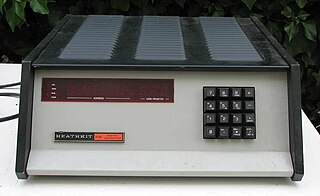 W
WHeathkit's H8 is an Intel 8080A-based microcomputer sold in kit form starting in 1977. The H8 was similar to the S-100 bus computers of the era, and like those machines was often used with the CP/M operating system on floppy disk.
 W
WThe IMSAI 8080 was an early microcomputer released in late 1975, based on the Intel 8080 and later 8085 and S-100 bus. It was a clone of its main competitor, the earlier MITS Altair 8800. The IMSAI is largely regarded as the first "clone" microcomputer. The IMSAI machine ran a highly modified version of the CP/M operating system called IMDOS. It was developed, manufactured and sold by IMS Associates, Inc.. In total, between 17,000 and 20,000 units were produced from 1975 to 1978.
 W
WThe Intellec computers were a series of early microcomputers Intel produced in the 1970s as a development platform for their processors. The Intellec computers were among the first microcomputers ever sold, predating the Altair 8800 by at least two years.
 W
WK-202 was a 16-bit minicomputer, created by a team led by Polish scientist Jacek Karpiński between 1970–1973 in cooperation with British companies Data-Loop and M.B. Metals. Approximately 30 units were claimed to be produced. All units shipped to M.B. Metals were returned for service. Due to friction resulting from competition with Elwro, a government-backed competitor, the production of K-202 was blocked and Karpiński thrown out of his company under the allegations of sabotage and embezzlement.
 W
WThe Kansas City standard (KCS), or Byte standard, is a way of storing digital data on standard Compact Audio Cassettes at data rates of 300 to 2400 bits per second that was first defined in 1976. It originated in a symposium sponsored by Byte magazine in November 1975 in Kansas City, Missouri to develop a standard for storage of digital microcomputer data on inexpensive consumer quality cassettes.
 W
WThe Kenbak-1 is considered by the Computer History Museum and the American Computer Museum to be the world's first "personal computer", invented by John V. Blankenbaker (1930-) of Kenbak Corporation in 1970, and first sold in early 1971. Only 50 machines were ever built using Bud Industries enclosures as its housing per the Oral History of John Blankenbaker. The system first sold for US$750. Today only 14 machines are believed to exist worldwide, in the hands of various collectors. Production of the Kenbak-1 stopped in 1973 as Kenbak failed, and was taken over by CTI Education Products, Inc. CTI rebranded the inventory and renamed it the H5050, though sales remained elusive.
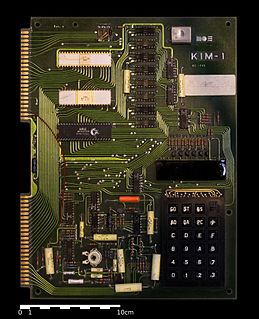 W
WThe KIM-1, short for Keyboard Input Monitor, is a small 6502-based single-board computer developed and produced by MOS Technology, Inc. and launched in 1976. It was very successful in that period, due to its low price and easy-access expandability.
 W
WThe educational computer LC80 was a single-board computer manufactured in the German Democratic Republic (GDR) and intended for teaching purposes. It was the first computer that retail customers could buy in the GDR.
 W
WLYS-16 was an early microcomputer based on the IMP-16 making it one of the first 16 bit microcomputers. It was designed and made by members of the Lysator academic computer club at Linköping University, Sweden
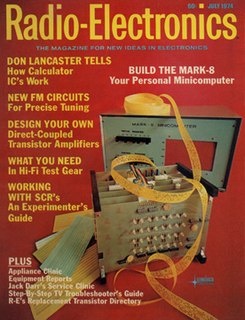 W
WThe Mark-8 is a microcomputer design from 1974, based on the Intel 8008 CPU. The Mark-8 was designed by Jonathan Titus, a Virginia Tech graduate student in Chemistry. After building the machine, Titus decided to share its design with the community and reached out to Radio-Electronics and Popular Electronics. He was turned down by Popular Electronics, but Radio-Electronics was interested and announced the Mark-8 as a 'loose kit' in the July 1974 issue of Radio-Electronics magazine.
 W
WThe MEK6800D2 was a development board for the Motorola 6800 microprocessor, produced by Motorola in 1976. It featured a keyboard with hexadecimal keys and an LED display, but also featured an RS-232 asynchronous serial interface for a Teletype or other terminal. Data and programs could be loaded from and saved to an audio cassette tape. There was an on-board monitor program called JBUG fitted in a 1K byte ROM, and the maximum RAM capacity on board was 512 bytes, but this could be expanded via the Motorola EXORciser computer bus interface.
 W
WThe Memotech MTX500, MTX512 and RS128 are a series of Zilog Z80A processor-based home computers released by Memotech in 1983 and 1984. They were technically similar to MSX computers, but were not compatible.
 W
WMicral is a series of microcomputers produced by the French company Réalisation d'Études Électroniques (R2E), beginning with the Micral N in early 1973. The Micral N was the first commercially available microprocessor-based computer.
 W
WThe Micro-Professor MPF-I, introduced in 1981 by Multitech, was the first branded computer product from Multitech and probably one of the world's longest selling computers. The MPF-I, specifically designed to teach the fundamentals of machine code and assembly language, is a simple and easy to use training system for the Zilog Z80 microprocessor.
 W
WA microprocessor development board is a printed circuit board containing a microprocessor and the minimal support logic needed for a computer engineer to become acquainted with the microprocessor on the board and to learn to program it. It also served users of the microprocessor as a method to prototype applications in products.
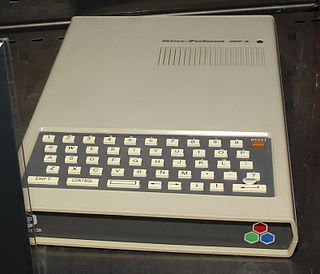 W
WMicroprofessor II, introduced in 1982, was Multitech's second branded computer product and also one of the earliest Apple II clones. It does not look like most other computers. The case of the MPF II was a slab with a small chiclet keyboard on its lower part.
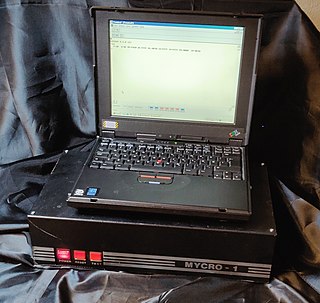 W
WThe MYCRO-1 was a microcomputer manufactured and sold by Mycron of Oslo, Norway. Built around the Intel 8080 CPU, it was one of the first commercial single-board computer after the Intel SDK-80. One is currently displayed at the Norwegian Museum of Science and Technology.
 W
WThe Nascom 1 and 2 were single-board computer kits issued in the United Kingdom in 1977 and 1979, respectively, based on the Zilog Z80 and including a keyboard and video interface, a serial port that could be used to store data on a tape cassette using the Kansas City standard, and two 8-bit parallel ports. At that time, including a full keyboard and video display interface was uncommon, as most microcomputer kits were then delivered with only a hexadecimal keypad and seven-segment display. To minimize cost, the buyer had to assemble a Nascom by hand-soldering about 3,000 joints on the single circuit board.
 W
WThe Newbear 77-68 was a kit of parts from which a purchaser could construct a first generation home computer based around a Motorola 6800 microprocessor. Because it was designed to be assembled by its owner at home, it was also a homebuilt computer. The 77-68 was designed by Tim Moore and was offered for sale by Bear Microcomputer Systems of Newbury, Berkshire, England from June 1977. It was among the first, if not the first, of British home computers and was featured in the launch edition of Personal Computer World magazine in February 1978.
 W
WThe North Star Horizon was a popular 8-bit S-100 bus computer introduced in October 1977. Like most S-100 machines of the era, it was built around the Zilog Z80A microprocessor, and typically ran the CP/M operating system. It was produced by North Star Computers, and it could be purchased either in kit form or pre-assembled. The North Star Horizon was one of the first computers to have built in floppy drives as well as being one of the first computers to have a hard disk drive.
 W
WOhio Scientific Inc. was an Ohio-based computer company that built and marketed microcomputers from 1975 to 1981. Their best-known products were the Challenger series of microcomputers and Superboard single-board computer kits.
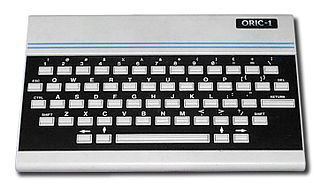 W
WOric was the name used by UK-based Tangerine Computer Systems for a series of 6502-based home computers sold in the 1980s, primarily in Europe.
 W
WPercom Data was an early microcomputer company formed in 1976 to sell peripherals into the emerging microcomputer market. They are best known for their floppy disk systems, first for S-100 machines, and the later for other platforms like the TRS-80 and the Atari 8-bit family. The company was purchased by Esprit Systems in 1984.
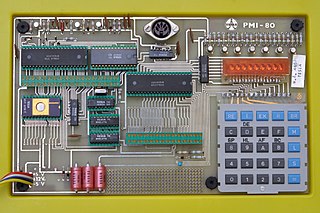 W
WThe PMI-80 was a single-board microcomputer produced by Tesla Piešťany, Czechoslovakia, since 1982. It was based on the MHB 8080A CPU, clocked at 1.111 MHz. Instead of a raster graphic display output and classical keyboard, it had a calculator-style nine-digit seven-segment red LED display and a 25-key calculator-type keypad with hexadecimal and function keys. The PMI-80 had 1 KiB of ROM and fixed 1 KiB of RWM. Eight I/O lines were provided for user along with complete system bus. Connected could be e.g., a card with a DAC of 0–12 V range.
 W
WThe Research Machines 380Z was an early 8-bit microcomputer produced by Research Machines in Oxford, England, from 1977 to 1985.
 W
WSCELBI was an early model of microcomputer based on the Intel 8008 processor. The company SCELBI Computer Consulting in 1973, by Nat Wadsworth. The SCELBI 8H was marketed in 1974 and was delivered either as an assembled unit or as a kit, with five basic circuit boards and provision for memory expansion to 16 kB. The company offered input/output devices including a keyboard, teleprinter interface, alphanumeric oscilloscope interface, and a cassette tape interface for data storage. The basic system only used a front panel with 11 switches and LEDs for input and output.
 W
WThe Sharp MZ is a series of personal computers sold in Japan and Europe by Sharp beginning in 1978.
 W
WThe 8X300 is a microprocessor produced and marketed by Signetics starting 1976 as a second source for the SMS 300 by Scientific Micro Systems, Inc.
 W
WThe Signetics 2650 was an 8-bit microprocessor introduced in mid-1975. According to Adam Osborne's book An Introduction to Microprocessors Vol 2: Some Real Products, it was "the most minicomputer-like" of the microprocessors available at the time. A combination of missing features and odd memory access limited its appeal, and the system saw little use in the market. Signetics became better known as a second-source supplier for the MOS 6502.
 W
WThe Sol-20 was the first fully assembled microcomputer with a built-in keyboard and television output, what would later be known as a home computer. The design was a combination of an Intel 8080-based motherboard, a VDM-1 graphics card, the 3P+S I/O card to drive a keyboard, and circuitry to connect to a cassette deck for program storage. Additional expansion was available via five S-100 bus slots at the back of the machine. It also included swappable ROMs with a rudimentary operating system.
 W
WOhio Scientific Inc. was an Ohio-based computer company that built and marketed microcomputers from 1975 to 1981. Their best-known products were the Challenger series of microcomputers and Superboard single-board computer kits.
 W
WSouthwest Technical Products Corporation, or SWTPC, was a US producer of electronic kits, and later complete computer systems. It was incorporated in 1967 in San Antonio, Texas, succeeding the 1964 DEMCO. Around 1990, SWTPC became Point Systems, before ceasing a few years later.
 W
WThe SYM-1 was a single board "trainer" computer produced by Synertek Systems Corp in 1975. It was designed by Ray Holt. Originally called the VIM-1, that name was later changed to SYM-1.
 W
WThe Tangerine Microtan 65 is a 6502 based single board microcomputer, first sold in 1979, which could be expanded into, what was for its day, a comprehensive and powerful system. The design became the basis for what later became the ORIC ATMOS and later computers, which has similar keyboard addressing and tape I/O as in the Microtan 65. The Microtan 65 has a single step function that can be used for debugging at the hardware level. The computer was available as ready-built boards or as kits consisting of board and components requiring soldering together.
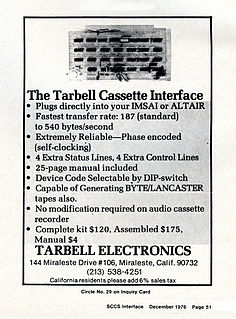 W
WThe Tarbell Cassette Interface is an expansion card for use with the Altair 8800 early personal computer, or other systems using the Altair's S-100 bus. It was designed by Don Tarbell and sold by Tarbell Electronics as early as 1976. At the time, it was considered to be fast, reliable, and popular. While supporting the 1975 Kansas City (Byte/Lancaster) standard, it also introduced a much faster Tarbell standard which became a de facto standard for compact cassette data storage.
 W
WThe TEC-1 is a single-board kit computer first produced by the Australian hobbyist electronics magazine Talking Electronics in the early 1980s. The design by John Hardy and Ken Stone was based on the Zilog Z80 CPU, had 2K of RAM and 2K of ROM in a default configuration. Later versions used a 4k ROM with two different versions of the monitor software selectable via a switch. This allowed the early software presented in the magazine to be used with the later version of the TEC-1.
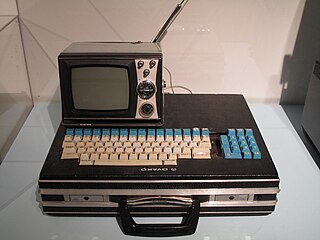 W
WThe Telmac 1800 was an early microcomputer delivered in kit form. It was introduced in 1977 by Telercas, the Finnish importer of RCA microchips. Most of the 2,000 kits manufactured were bought by electronics enthusiasts in Finland, Sweden and Norway.
 W
WThe Telmac TMC-600 was a Finnish microcomputer produced during the early 1980s starting in 1982. It was introduced in 1982 by Telercas, the Finnish importer of RCA microchips. Only 600 units were produced, making it very rare today. The TMC-600 was the only commercially available BASIC-based home computer designed and manufactured in Finland.
 W
WThe TK-80 was an 8080-based single-board computer kit developed by Nippon Electric Company (NEC) in 1976. It was originally developed for engineers who considered using the μCOM-80 family in their product. It was successful among hobbyists in late 1970s in Japan, due to its reasonable price and an expensive computer terminal not being required.
 W
WThe TV Typewriter was a video terminal that could display two pages of 16 lines of 32 upper case characters on a standard television set. The design, by Don Lancaster, appeared on the cover of Radio-Electronics magazine in September 1973.
 W
WViatron Computer Systems, or simply Viatron was an American computer company headquartered in Bedford, Massachusetts, and later Burlington, Massachusetts. Viatron coined the term "microprocessor" although it was not used in the sense in which the word microprocessor is used today.
 W
WThe Sinclair ZX80 is a home computer launched on 29 January 1980 by Science of Cambridge Ltd.. It is notable for being one of the first computers available in the United Kingdom for less than a hundred pounds. It was available in kit form for £79.95, where purchasers had to assemble and solder it together, and as a ready-built version at £99.95. The ZX80 was very popular straight away, and for some time there was a waiting list of several months for either version of the machine.